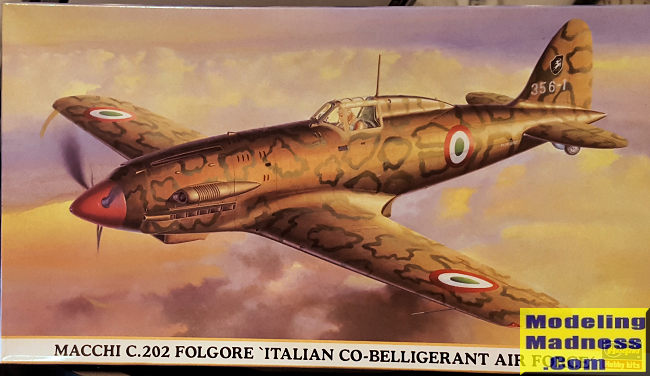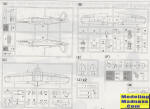
Hasegawa 1/48 Macchi C.202 "Italian Co-belligerant Air Force"
| KIT #: | 09504 |
| PRICE: | 2400 yen when new |
| DECALS: | Two options |
| REVIEWER: | Scott Van Aken |
| NOTES: | 2003 Limited Edition |

| HISTORY |
The Macchi C.202 Folgore (Italian "thunderbolt") was an Italian fighter aircraft developed and manufactured by Macchi Aeronautica. It was operated mainly by the Regia Aeronautica (RA; Royal (Italian) Air Force) in and around the Second World War. According to aviation author David Mondey, the Folgore has been considered to be one of the best wartime fighters to serve in large numbers with the Regia Aeronautica.
The C.202 was designed by a team headed by the company's chief of design, Italian aeronautics engineer Mario Castoldi. As per company tradition, Macchi aircraft designed by Mario Castoldi received the "C" letter in their model designation, hence the Folgore is commonly referred to as the C.202 or MC.202. The C.202 was a development of the earlier C.200 Saetta, powered by an Italian-built version of the German Daimler-Benz DB 601Aa engine and featuring a redesigned fuselage for greater streamlining.
During July 1941, the Folgore went into service with the Regia Aeronautica. In combat, it very quickly proved itself to be an effective and deadly dogfighter against its contemporaries. During its service life, the C.202 was deployed on all fronts in which Italy was involved. During late 1941, it commenced offensive operations over Malta and in North Africa, where Italian and German forces were engaged in heavy combat against British and later American operations. The C.202 continued to be used in North Africa as late as mid-1943, by which point the type was withdrawn to support defensive efforts in Sicily and the Italian mainland following their invasion by Allied forces. It also saw limited use on the Eastern Front. Following the 1943 Armistice with Italy, the type was mostly used as a trainer aircraft. The type was also operated by Croatia.
The Australian ace Clive Caldwell, who fought a wide variety of German, Italian and Japanese fighters during 1941–45, later stated that the C.202 was "one of the best and most undervalued of fighters". The C.202 also had its defects: like its predecessor, the C.200, it could enter a dangerous spin. The radios were unreliable, routinely forcing pilots to communicate by waggling their wings and Western historians regard the C.202 as insufficiently armed, being furnished with just a pair of machine guns that had a tendency for jamming. Still in mid-Summer 1942, in North Africa, the Folgore achieved a ratio kill/loss better than that of the Messerschmitt Bf 109s.
| THE KIT |
 Hasegawa
produced this kit in a variety of boxings and variants. It was also the base for
the C.205, which also saw a number of releases over the years. For many builders
this is still the best there is in this scale. Their 1/72 kit no slouch either.
Hasegawa
produced this kit in a variety of boxings and variants. It was also the base for
the C.205, which also saw a number of releases over the years. For many builders
this is still the best there is in this scale. Their 1/72 kit no slouch either.
Hasegawa went through a major tooling run for various single engine fighters in the early 1990s and so you will find a comparable level of detail in all the kits of the time and that includes this one. Interiors are well done with separate floor, and sidewalls. Add in there a set of rudder pedals, control stick, seat and instrument panel into a small assembly which fits neatly into the fuselage. The instrument panel has both raised detail and decals for those so inclined.
Once the fuselage halves are closed, one adds
the tailplanes and the upper cowling. Instructions then move to the wings with
the standard lower wing with two upper halves and a very nicely detailed main
gear well. This is now
 attached
to the fuselage and then one attaches the lower cowling, ventral radiator and
the main landing gear. During this time, Hasegawa was big into the separate prop
blades. This plugs into the front of the cowling. Finally one goes with the the
final pieces like tail wheel, exhaust, and the windscreen/canopy. One could pose
the canopy open as it hinges to the side.
attached
to the fuselage and then one attaches the lower cowling, ventral radiator and
the main landing gear. During this time, Hasegawa was big into the separate prop
blades. This plugs into the front of the cowling. Finally one goes with the the
final pieces like tail wheel, exhaust, and the windscreen/canopy. One could pose
the canopy open as it hinges to the side.
Instructions are standard fare with Gunze paint references. There are two markings options. One is the box art plane in tan uppers with light grey lowers and green 'smoke rings' on the upper surface. The other has a solid dark green upper surface. Decals are nicely printed, but are old school with the whites that are actually an off-right. It might be useful to go to aftermarket if you are not.
| CONCLUSIONS |
This is a nice kit with almost no vices. It makes into a great model for your shelf and if you are squeamish about the complex camo option, you can do the easy one.
| REFERENCES |
https://en.wikipedia.org/wiki/Macchi_C.202
March 2020 Copyright
ModelingMadness.com. All rights reserved. If you would like your product reviewed fairly and fairly quickly, please contact the editor or see other details in the
Note to
Contributors. Back to the Main Page
Back to the Review
Index Page
Back to the Previews Index Page